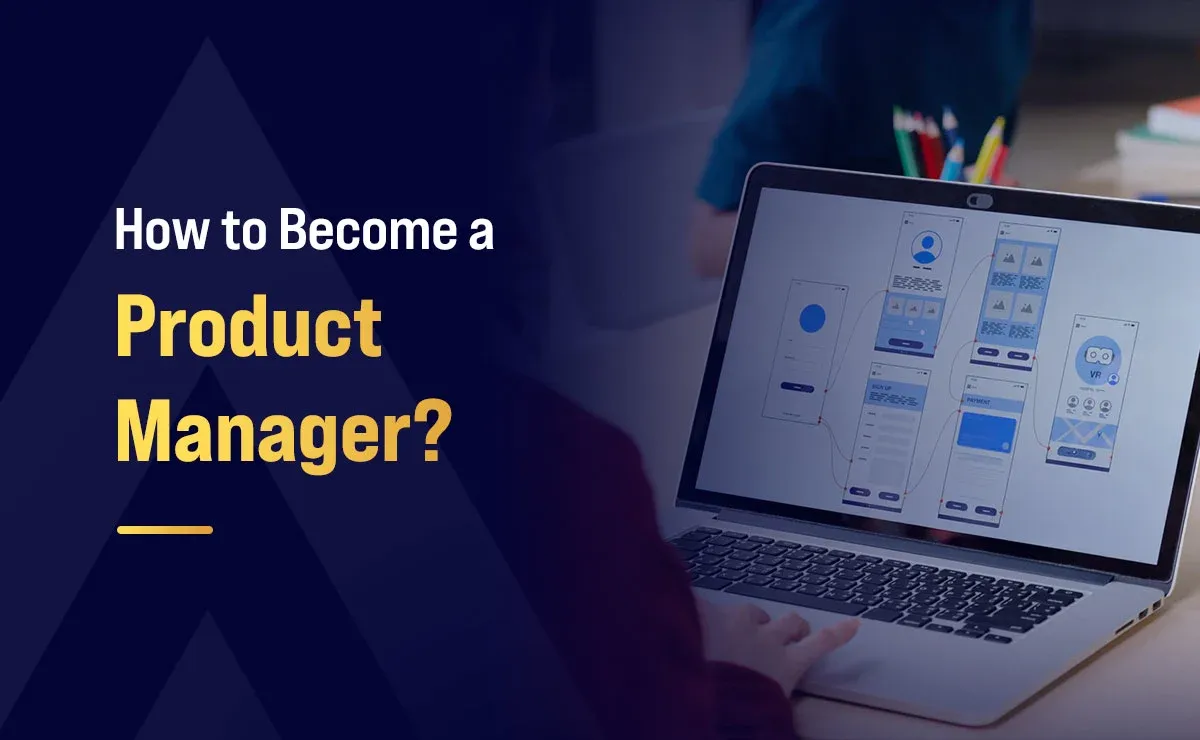How to Become a Product Manager?

If you've ever looked at a product and thought, “I could make this better,” chances are you’ve already got the product manager mindset. Product management represents one of today's most versatile and influential professional trajectories. It blends creativity, business strategy, and customer empathy into a single role that sits at the intersection of technology and user experience.
Whether you’re fresh out of school, a working professional exploring a new direction, or someone without a tech background, becoming a product manager (PM) is within reach.
Let’s explore what product management is, what PMs do, and exactly how you can break into this exciting career.
What is Product Management?

Product management is a business function that focuses on the strategy, development, launch, and continual improvement of a product or service. Depending on the company, product management can cover everything from research and development to post-launch customer feedback.
While duties may differ between companies, product managers generally operate at the nexus of business strategy, technology, and customer experience. They act as the voice of the customer while balancing technical constraints and business objectives, making product management a role that is both strategic and deeply collaborative.
What Does a Product Manager Do?
Although responsibilities fluctuate between companies, product managers typically function at the convergence of business interests, technological capabilities, and customer experience design. In essence, they sit at the center of business, technology, and user needs, ensuring all teams are aligned toward a common goal. Their typical tasks include:
- Conducting Research: One of the foundational responsibilities of a product manager is to conduct in-depth research to understand the market trends, customer needs, and competitor offerings. This research helps identify unmet needs, market gaps, and potential opportunities that can guide product development and positioning.
- Developing Strategy: Based on the insights gathered from research, product managers craft a high-level strategy that defines the product vision, goals, and roadmap. This strategic planning ensures the product aligns with the broader business objectives and creates value for both the company and its users.
- Communicating Plans: A critical part of the product manager’s role is to effectively communicate the product vision and strategy to internal stakeholders. This involves collaborating with leadership, designers, developers, sales teams, and marketers to maintain alignment and drive unified objectives.
- Developing Coordination: Once a product vision is greenlit, product managers partner with multidisciplinary teams to transform ideas into tangible solutions. They help prioritize features, manage timelines, and ensure smooth coordination between departments to deliver the product efficiently and on schedule.
- Feedback Analysis: Post-launch, product managers track user engagement, gather insights, and assess metrics to measure the product’s success and areas for improvement. These insights inform future improvements and feature enhancements and help guide the product's evolution in the market.
- Ensuring Alignment with Business Objectives: A successful product isn’t just loved by users—it also supports the company’s broader goals. Product managers make sure their product strategy aligns with business objectives like revenue growth, user acquisition, retention, or market expansion. They monitor essential performance metrics to evaluate progress and recalibrate approaches when circumstances demand.
Unlike project managers, who prioritize deliverables and schedules, product managers concentrate on defining the product’s purpose and strategic value.
Product Manager Skills

Product management operates at the nexus where business requirements, technological possibilities, and user needs converge. To thrive in this multifaceted role, a product manager must be equipped with a diverse set of skills that range from technical fluency to empathetic communication. Below is a deep dive into the essential skills every product manager should develop:
Technical Expertise
While product managers don’t need to be coders, a strong understanding of the technical side of product development is crucial. This includes knowledge of how web and mobile applications are built, understanding development workflows, and being familiar with common technologies used by your engineering teams.
Technical proficiency enables effective dialogue with engineering teams, comprehension of limitations, realistic timeline forecasting, and data-driven decision-making. Learning to "speak the developers' language" strengthens collaboration and ensures the product is built as envisioned.
User Experience (UX) Awareness
An exceptional product delivers both functionality and intuitive usability. Product managers advocate for customers, ensuring solutions address authentic challenges while providing frictionless interactions.
While you don’t need to be a UX designer, understanding design thinking, usability principles, and accessibility standards will help you work closely with design teams and advocate for user-centric solutions throughout the product lifecycle.
Business Acumen
Product managers must comprehend how their offerings contribute to achieving broader organizational strategies. This involves a grasp of budgeting, cash flow, customer acquisition costs, profit margins, and key performance indicators (KPIs).
Business-savvy PMs can assess how a feature or product contributes to long-term goals, tie day-to-day decisions back to revenue or growth strategies, and speak the language of stakeholders and executives.
Critical Thinking
Decision-making is a daily task in product management. Critical thinking involves analyzing facts, evaluating trade-offs, and making well-informed choices that serve both user needs and business objectives.
Whether prioritizing features, resolving team conflicts, or making roadmap decisions, strong critical thinking enables PMs to navigate complexity and ambiguity with confidence.
Data Analysis
In a world driven by data, product managers must be comfortable with interpreting metrics and drawing actionable insights. You’ll use data to:
- Understand user behavior.
- Identify market trends.
- Test product hypotheses.
- Track success against KPIs.
- Uncover areas for improvement.
You don’t need to be a data scientist, but you should be able to work with tools like Excel, Google Analytics, or Amplitude—and interpret the data to inform strategy.
Research Skills
Great products are born from deep insights about the market, users, and competitors. Product managers conduct both qualitative and quantitative research to:
- Identify user pain points.
- Understand market trends.
- Evaluate competitive offerings.
- Validate product ideas.
Strong research skills enable you to keep learning continuously, anticipate user needs, and make evidence-backed decisions.
Problem-Solving
Fundamentally, product management revolves around resolving actual challenges—both for end-users and the organization itself. Whether it’s identifying new features, improving internal processes, or working within constraints like limited time or budget, problem-solving is a daily habit.
The best PMs approach challenges with creativity, resourcefulness, and a mindset of continuous improvement.
AI Tool Proficiency
As AI continues to shape the future of product development, product managers are expected to know how to leverage AI tools. This includes using AI to automate tasks, generate insights, or enhance product features.
Being familiar with tools like ChatGPT, Bard, Notion AI, or Jira-integrated assistants helps PMs work smarter, not harder. But it's not just about using these tools—PMs must also understand the ethical and responsible use of AI in product development.
Strategic Thinking
Strategic analysis forms the cornerstone of effective product management practice. It means aligning product decisions with long-term goals, foreseeing challenges, and planning for scalability and sustainability.
Every feature prioritized, every design change made, and every launch decision should contribute to the product’s overarching vision. A strategic mindset ensures that short-term wins don’t distract from long-term impact.
Communication Skills
Transparent, understanding, and reliable communication stands as perhaps the most essential competency for product management professionals. You’ll be working across multiple departments—engineering, design, sales, marketing, and leadership. Strong communication helps in:
- Explaining complex ideas simply.
- Facilitating cross-functional meetings.
- Creating alignment around product vision and priorities.
- Delivering tough messages with empathy.
PMs must also be active listeners, as true collaboration depends on two-way communication.
Storytelling Ability
Product managers must be able to inspire belief in the product vision—from stakeholders to customers. Storytelling helps communicate why a product matters, who it helps, and what makes it special. A good story can:
- Build excitement around a product roadmap.
- Align teams around a shared mission.
- Drive product adoption during launch.
Mastering storytelling allows you to make data, roadmaps, and strategy more engaging and memorable.
Why Pursue a Career in Product Management?
Here are the main reasons why people from various backgrounds, including engineering, design, marketing, and consulting, can and should pursue a career in product management.
- Provides Opportunities in High Impact Role: Product managers play a central role in shaping the direction and success of a product. From identifying user problems to launching solutions that directly impact customers and drive revenue, PMs are at the heart of innovation. For those seeking to drive measurable organizational impact, this position delivers precisely that opportunity.
- Allows Cross-Functional Collaboration: Product management is perfect for people who love working with diverse teams. As a PM, you’ll collaborate with engineers, designers, marketers, analysts, and senior leaders. You’ll act as the glue that brings everyone together to build something meaningful, making it an ideal role for strong communicators and natural leaders.
- Promotes Constant Learning: Product management presents constant variety, with each workday bringing unique challenges and opportunities. You’ll be exposed to different domains, including technology, design, business strategy, user behavior, and more, as you constantly solve new challenges. This environment is perfect for curious minds who love learning and growing across disciplines.
- Provides Excellent Career Growth: Product manager roles are in high demand across industries, especially in tech-driven companies. As enterprises increasingly depend on digital solutions for competitive advantage, demand for talented product managers has surged dramatically. With experience, PMs can move into leadership roles like Head of Product, Director of Product, or even Chief Product Officer.
- Provides Competitive Salaries: PMs are well-compensated for the responsibilities they shoulder. Salaries are competitive across industries, with additional perks in tech companies such as stock options, bonuses, and remote flexibility—making it a financially rewarding career path.
In short, product management is ideal for people who want to build, lead, and innovate—without being confined to just one area of expertise.
How to become a Product Manager?

Breaking into product management can feel overwhelming—but it’s achievable with the right plan and mindset. Whether you're a student, early-career professional, or someone transitioning from another field, you don’t need a perfect background to become a PM. What you truly require is a well-defined trajectory, deliberate skill acquisition, and proactive career development. Here’s how to get started:
Gain Foundational Knowledge
To step into product management, you need a strong foundation in business strategy, technology, and user-centered design. This means understanding:
- How businesses operate, how products create value, and what drives revenue and growth. This could come from a business degree, internships, or online courses.
- How technical implementation processes work for product development. You don’t need to code, but understanding the software development lifecycle, technical constraints, and how to communicate with engineers is vital.
- What makes for a great user experience? Develop an eye for intuitive user interfaces and empathy for user needs. Learning basic UX principles and human-centered design helps you advocate for your users effectively.
While formal education in these key areas is important, self-learning through books, online courses, and real-world observation can also equip you with the essential knowledge to get started.
Get Certified from Recognized Institutions and Programs
Earning a product management certification helps bridge the gap between theory and practical application, especially if you’re new to the field. Certifications also help validate your skills when you don’t yet have direct experience.
Choose a course that includes real-world case studies, industry tools (like Jira, Figma, or Productboard), and opportunities to build projects. Certifications demonstrate commitment, boost your resume, and often connect you with a network of peers and mentors.
Learn Practical Application of Skills
It’s not enough to know what product managers do; instead, you need to practice how they do it. Apply your knowledge by:
- Engaging with authentic or simulated initiatives requiring product-oriented thinking. This might involve problem definition, customer research activities, or strategic roadmap development.
- Collaborating with designers and developers (even as a side project) to understand how cross-functional teams work.
- Taking initiative by leading a minor project in a professional, academic, or extracurricular setting to build relevant experience.
Hands-on experience, even in an informal setting, will accelerate your learning and help you build confidence.
Build a Product Portfolio
Your portfolio is proof of your ability to think like a product manager even before you land your first job. Document your projects, explain the problems you addressed, the research you conducted, the decisions you made, and the outcomes that followed.
You don’t need to wait for a paid role to build one; use side projects, redesign existing products, or join hackathons to generate work you can proudly showcase. Recruiters value clear, strategic thinking and problem-solving over polished aesthetics.
Leverage Networking Opportunities
Networking is a powerful tool for community building that can help you break into product management roles. You can leverage networking by:
- Participating in product management forums across platforms like LinkedIn, Slack channels, or Reddit communities.
- Attending webinars, local meetups, or conferences (even virtually).
- Reaching out for coffee chats or informational interviews with PMs and ask thoughtful questions about their path and experiences.
These connections can offer insights, mentorship, referrals, and sometimes even direct job leads. Don't hesitate to request informational discussions, as most product managers willingly share insights about their professional journey.
Tailor Job Search Strategy
When you’re ready to apply, be intentional about the roles you target.
- Look for associate product manager (APM) roles, PM internships, or entry-level PM programs (Google, Meta, and Atlassian all offer APM tracks).
- Customize your resume to highlight transferable skills: leadership, communication, decision-making, data analysis, etc., and align your experience with what the job posting requires.
- Use your portfolio to stand out, especially if you don’t have formal PM experience.
A focused, well-researched application stands out more than a generic one sent in bulk.
Prepare for Interviews
PM interviews are designed to evaluate both your analytical and interpersonal abilities. Be ready to discuss how you solve problems, prioritize features, handle feedback, and work with different teams. Practice frameworks like CIRCLES or AARM to structure your responses to product design and execution questions.
Don’t neglect behavioral questions either—being able to articulate your thought process, past challenges, and learning moments is just as important as having the right answers.
Transitioning into Product Management Without Product Experience
If you are wondering how to become a product manager without experience, you don’t need a traditional background in product to become a product manager. In fact, many successful PMs have transitioned from roles in marketing, UX design, customer support, engineering, operations, and even education.
The crucial factors are your capacity for strategic reasoning, solution development, and interdisciplinary leadership—capabilities that can be cultivated across various professional roles.
To transition successfully:
- Leverage your existing skills (e.g., communication, project leadership, analytics.)
- Volunteer for product-adjacent projects.
- Shadow a PM at your current company.
- Document your contributions in a portfolio.
- Highlight problem-solving and impact in your resume.
Remember, companies are increasingly open to hiring for potential, not just past titles. If you can demonstrate a clear understanding of the product development process and show that you’re already thinking like a PM, you’re well on your way to making the leap.
FAQs
Q1. What are the qualifications for a product manager?
Ans: No predetermined pathway exists for entering product management. While many professionals emerge from business, technology, or design backgrounds, the essential qualifications involve competencies like strategic insight, effective communication, leadership ability, and analytical problem-solving.
While a degree in business, computer science, or a related field can help, many product managers succeed by building hands-on experience and showcasing their ability to deliver value.
Q2. Is an MBA necessary for a product manager?
Ans: An MBA provides the most convenient pathway to land a product manager role and is surely very advantageous. It helps gain industry-relevant business knowledge and opens doors at some top companies; however, many professionals also break into the field without an MBA degree. Relevant experience, certifications, and a strong product portfolio often carry more weight, especially for entry- or mid-level roles.
Q3. How to become a product manager in India after 12th?
Ans: To start your journey after 12th grade, focus on building foundational skills in business, technology, and design through a bachelor’s degree or self-paced learning. You can pursue courses or certifications in product management, gain experience by working on projects or internships, and build a portfolio. Starting early gives you a head start as you stay curious, keep learning, and get involved with product-building communities or internships when possible.
Summing Up
Breaking into product management doesn’t require a perfect background—it requires curiosity, commitment, and a willingness to learn. Whether you’re just starting your career or transitioning from another field, there are clear, actionable steps you can take to become a product manager: build foundational knowledge, practice real-world skills, grow your network, and showcase your thinking through a strong portfolio.
If you’re passionate about solving problems, building meaningful products, and working at the intersection of people, business, and technology, then this could be the perfect path for you. With the right strategy and persistence, landing your first PM role is possible.

